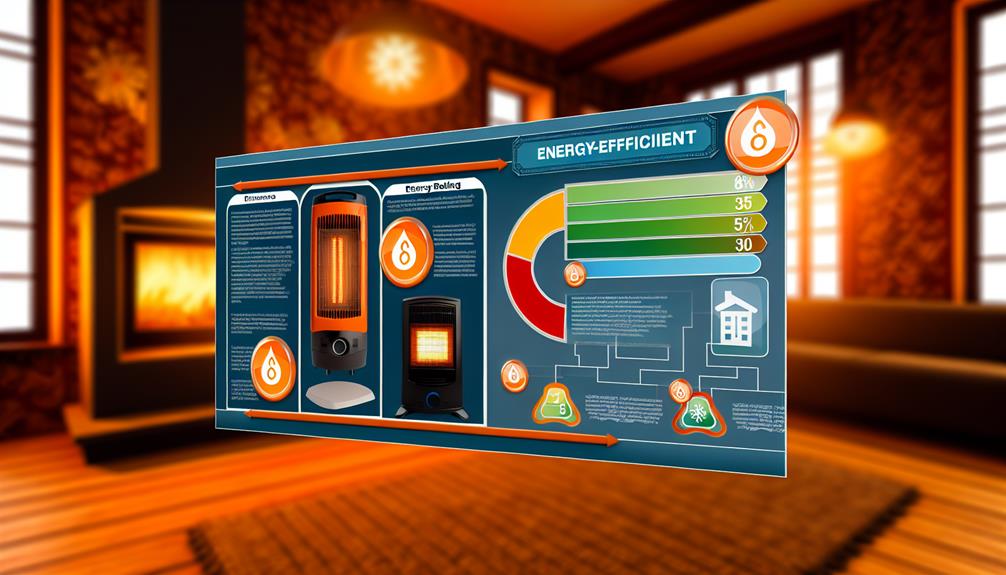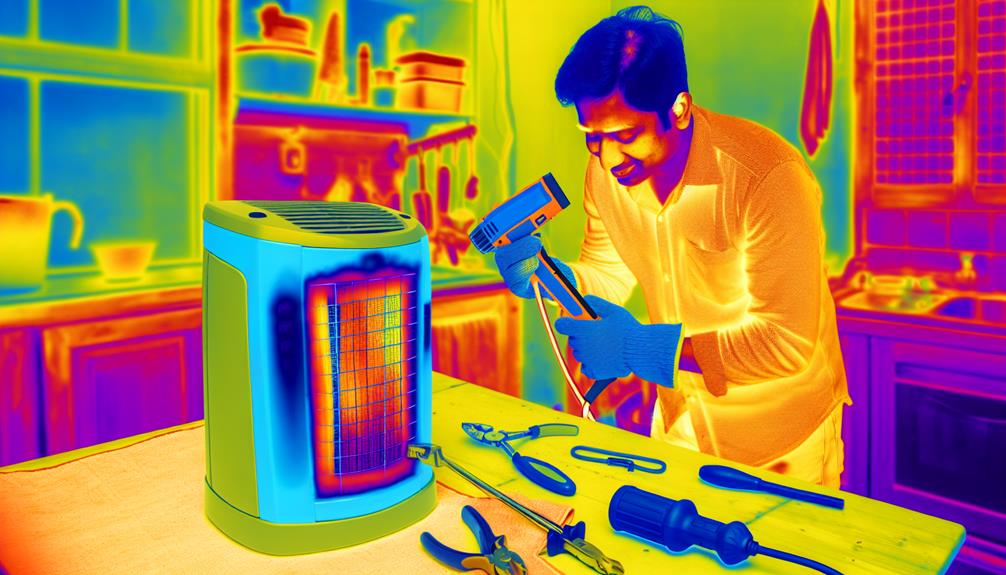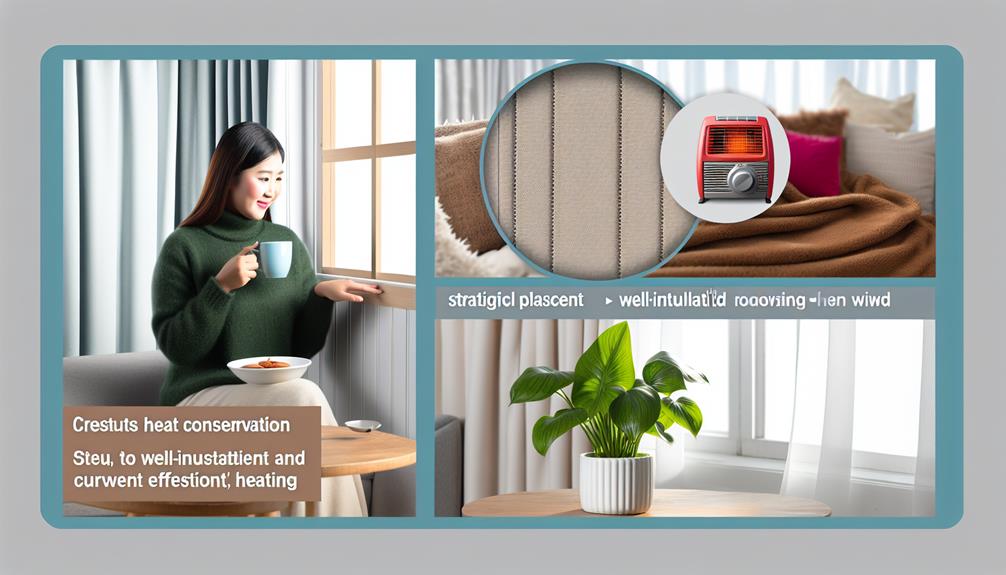As you select, position, and operate your portable heater, you're not just combating the cold—you're also making decisions that impact your energy consumption and cost. In your hands lies the potential to transform how you use these convenient appliances without sacrificing comfort for efficiency. It's essential to navigate the fine line between staying warm and being energy conscious, especially when the chill of winter seizes your space. With a few strategic choices regarding type, placement, and usage, you can ensure your portable heater works for you in the most effective way. What you may not know are the simple yet often overlooked practices that could optimize your heater's performance and safety, all while keeping your bills in check. Let's explore how you can make the most of your portable heater without putting a freeze on your budget or the environment.
Key Takeaways
- Electric space heaters are nearly 100% efficient in converting electricity to heat.
- Select heaters with a thermostat for temperature control and independent certification for quality assurance.
- Assess the space's size and requirements to match the heater's capacity.
- Position the heater centrally in the room for even heat distribution and avoid obstructive furniture.
Understanding Portable Heater Types
When selecting a portable heater, it's essential to understand the different types available, as each has distinct features and efficiency levels tailored to various needs and spaces. Electric space heaters are nearly 100% efficient in converting electricity to heat, making them an energy-efficient choice for your heating system. They provide instant heat and are designed to be portable, which allows for targeted warmth in specific areas, potentially reducing overall energy consumption.
However, you should consider the cons such as government-regulated output, which limits the heating area. There's also the seasonal fire risk associated with these heaters, not to mention potential burn-related injuries. To ensure safe operation, look for space heaters equipped with a tip-over safety switch, which automatically shuts off the heater if it's knocked over, reducing the risk of fire.
When it comes to energy efficiency, consider heaters that use infrared radiation, as they directly warm objects and people in the room without wasting energy to heat the air. Finally, make sure to select a heater with a thermostat for temperature control and seek out those with independent certification for quality assurance. Always prioritize safety, opting for models with a cool-touch housing to prevent burns.
Assessing Space and Size Requirements
Before purchasing a portable heater, you need to accurately calculate the dimensions of the room you're aiming to heat. It's essential to match the heater's capacity to your space, ensuring it's powerful enough to warm the area without wasting energy. Keep in mind that the heater's wattage should align with the square footage and the space's unique characteristics, such as insulation and air flow.
Calculate Room Dimensions
To accurately gauge the heating requirements for your space, start by calculating the room's length, width, and height to determine its total volume in cubic feet. This initial step is crucial to understanding how much energy you'll need to heat a room effectively. Remember, an inadequately sized heater will struggle to maintain comfort, while an oversized unit can lead to wasted energy and higher costs.
Here's what you should consider:
- Each one square foot of space requires proper assessment.
- Calculate room dimensions to align with the heater's maximum output.
- Not all spaces are created equal; consider insulation and airflow.
- A heater's efficacy is measured by its ability to maintain a consistent temperature across every square foot of space.
Heater Capacity Matching
Having calculated the room dimensions, you'll next need to match the heater capacity to your space's size and requirements to ensure efficient and effective heating. A space heater, ideal for heating an entire home, consumes significant watts of electricity. To heat one room, energy efficiency peaks when you select a heater with the proper wattage, typically around 10 watts per square foot. Assess not just the square footage, but also consider insulation quality, potential air leaks, and the room's layout. Additionally, account for ceiling height and the number of windows and doors, which influence heating needs. In cases where one heater doesn't suffice, deploying multiple smaller heaters for larger or irregularly shaped spaces might be a more energy-efficient strategy.
Comparing Heater Energy Efficiency

When comparing the energy efficiency of portable heaters, it's crucial to note that electric space heaters boast nearly 100% efficiency in turning electricity into heat. This means that almost all the electricity they consume is converted to heat, making them a prime choice for energy-efficient usage. However, to truly save energy and optimize their benefits, you need to delve into the specifics.
Consider these factors:
- Heater Wattage: Government standards cap portable electric space heaters at 1,500 watts. Higher wattage doesn't necessarily mean more heat, but rather, how quickly a space can be heated.
- Environmental Variables: The efficiency of a heater is also dependent on external factors such as room insulation and the presence of drafts. Better insulation means less heat loss, thus more savings.
- Usage Patterns: Energy-efficient usage involves strategic operation, like only heating rooms that are in use, which can significantly reduce your energy consumption.
- Consumer Reviews: Websites offer a plethora of reviews and efficiency ratings. Do your research to find models that customers verify as percent efficient in their energy use.
Optimal Heater Placement Tips
To optimize your portable heater's performance, position it centrally in the room to ensure even distribution of warmth. Keep the heater clear of furniture that can block airflow, maintaining a direct line to the area you're heating. Use reflective surfaces behind the heater to enhance the heat spread without increasing energy consumption.
Central Room Positioning
For optimal heat distribution, place your portable heater in the room's center, ensuring it's at least three feet away from any objects to prevent fire hazards and facilitate even heat spread. Here are key points to remember:
- Safety First: Always maintain a safe distance from flammable materials to prevent accidents.
- Efficiency Matters: Central positioning allows your space heater to heat the room more effectively, reducing the need to crank up central heating.
- Mind the Gap: The three-foot rule is critical not just for safety, but also to heat a small area without energy waste.
- Circulation Is Key: Use a fan if necessary to help distribute the warmth evenly, ensuring your comfort and energy-efficient operation.
Avoiding Obstructive Furniture
Building on the importance of central room positioning, it's essential to also keep portable heaters away from obstructive furniture to ensure safe and effective heat distribution. Place your space heater away from objects and people, maintaining a minimum clearance of three feet to prevent fire hazards. Heaters use high temperatures to warm spaces, so it's crucial to avoid placing them near flammable materials or on unstable surfaces. Utilize the heater's safety features and refrain from using an extension cord, which can create additional risks. Analyze the room layout and airflow to optimize placement, steering clear of drafts or vents that may disrupt operation. Regularly check the area around your heater to maintain necessary clearance and ensure unimpeded performance.
Reflective Surface Utilization
When strategically placing a portable heater, incorporating reflective surfaces like aluminum foil or specialized heat-reflective panels behind and around the device can significantly enhance its heating efficiency by reflecting lost heat back into the room. Reflective surface utilization is a key aspect of energy-efficient heating. Here's how to optimize your setup:
- Align aluminum foil or heat-reflective panels directly behind the heater to reduce heat absorption by the wall.
- Place reflective materials on either side of the heater to focus heated air towards the center of the room.
- Ensure the reflective surfaces are fire-resistant and positioned safely to prevent hazards.
- Regularly check the placement for any damage to the reflective materials, ensuring continued optimal performance.
Thermostat and Timer Utilization
Maximizing the efficiency of portable heaters can be significantly achieved by properly setting thermostats and utilizing built-in timers. The thermostat is a critical component that regulates the heater's temperature, ensuring it maintains a consistent level of warmth without excessive energy consumption. By selecting an optimal temperature setting, you avoid the energy waste associated with overheating a space.
Timer utilization is equally vital for energy-efficient operation. Most portable heaters come equipped with timers that can be set to operate for a specific number of hours, ensuring that the heater only runs when necessary. This feature prevents the heater from operating continuously, which can lead to unnecessary energy expenditure.
Furthermore, the strategic use of a timer can align heating times with your daily schedule. For instance, setting the timer to activate the heater shortly before you wake up or return home can provide comfort without the cost of running the heater all day.
Additionally, the automatic shut-off function, often linked with timer settings, enhances safety by ensuring the heater doesn't operate unattended for extended periods. This not only conserves energy but also reduces the risk of overheating and potential fire hazards. By leveraging thermostat control and timer utilization, you'll maintain a comfortable environment while optimizing your portable heater's energy efficiency.
Maintenance for Maximum Efficiency

Beyond setting thermostats and timers, regular maintenance of your portable heater is crucial for sustaining peak energy efficiency and safety. The Consumer Product Safety Commission stresses the importance of following the manufacturer's instructions for care to ensure your space heater remains safe and efficient.
When maintaining your space heater, consider the following tasks:
- Clean the Heater: Dust and debris can hamper your heater's performance and pose a fire hazard. Regularly cleaning your heater ensures it operates efficiently and safely.
- Inspect the Power Cord: Damaged cords and plugs are not just a safety risk; they can also make your heater work harder, using more energy. Replace any worn parts immediately.
- Check the Thermostat: An inaccurate thermostat leads to energy waste. Calibrating it according to the manufacturer's instructions helps maintain the desired temperature without overworking the heater.
- Examine Fan and Motor: A malfunctioning fan or motor reduces heating efficiency. Listen for unusual sounds and monitor performance to catch issues early.
Lastly, don't forget to schedule annual professional inspections. Experts can identify and rectify hidden problems, keeping your space heater running smoothly and your energy bills in check.
Safety Considerations and Best Practices
Prioritizing safety while utilizing portable heaters not only prevents accidents but also contributes to their energy-efficient operation. It's crucial to select heaters with built-in safety features that the Product Safety Commission estimates will significantly reduce fire hazards. For example, a heater that automatically shuts off if tipped over can be a lifesaver, especially in homes with children and pets.
Reading and following the manufacturer's instructions is essential. It ensures you're aware of the specific safety measures for your device, including proper placement on a level surface to prevent tipping. Remember, a heater that's knocked over by a pet or a child not only poses a fire risk but could also lead to a malfunction, decreasing its efficiency.
Be vigilant about where you place your heater. Keep it at least three feet away from anything flammable and never leave it running unattended, especially overnight. This not only shuts off the heater as a potential hazard but also conserves energy. Avoid using extension cords, which can overheat and cause electrical fires. Here's a table summarizing key safety practices:
| Safety Feature | Purpose | Best Practice |
|---|---|---|
| Automatic Shut-off | Prevents overheating and fires | Ensure feature is activated |
| Tip-over Protection | Shuts off the heater if it falls over | Place on level surface, away from traffic |
| Proximity to Flammables | Reduces fire hazards | Keep a safe distance of at least 3 feet |
| Supervision | Prevents accidents with children and pets | Never leave heater unattended |
| Avoiding Extension Cords | Minimizes risk of electrical fires | Plug directly into wall outlet |
Supplemental Heating Strategies

While adhering to safety protocols ensures efficient use of portable heaters, exploring supplemental heating strategies can further enhance energy savings in your home. Electric space heaters, with near-perfect efficiency in converting electricity to heat, offer a viable option for targeted warmth, minimizing reliance on primary heating systems. However, to truly save money and boost energy efficiency, consider these supplemental heating strategies:
- Invest in Weatherization: Seal drafts and improve insulation to retain heat more effectively, reducing the overall workload on your space heater.
- Thermostat Management: Use models with adjustable thermostats to maintain comfortable temperatures without overheating, conserving energy and preventing wastage.
- Safety-First Approach: Opt for heaters with built-in safety features and use them in appropriate settings—like GFCI-equipped models in damp areas to mitigate risks and preserve energy.
- Strategic Placement: Position your space heater at least three feet from flammable objects and in the room where you spend most time, directing heat where it's needed most.
Analyzing Costs and Savings Potential
Evaluating the cost-effectiveness of portable electric space heaters involves assessing their energy consumption against potential savings on your heating bills. With a near 100 percent efficiency rating, these space heaters convert almost all electricity into heat, but it's essential to consider their limited 1,500-watt maximum output. To heat one square foot of space, it takes about 10 watts of electricity. Therefore, understanding the size of the area you want to heat one is crucial for estimating the potential energy use.
However, this is just a part of the equation. Your actual savings potential depends on several variables affecting a space heater's efficiency, including location, insulation quality, and the presence of air leaks, windows, and doors. A poorly insulated room with drafts will demand more energy to maintain a comfortable temperature, which can offset the efficiency of your space heater.
Manufacturers often claim that you can save up to 50 percent on your heating bills by using portable electric space heaters. While these savings are possible, they assume optimal conditions and strategic usage. To truly save energy, you must use the space heater in a well-insulated area and only when necessary to supplement your central heating system, rather than as the primary heat source.
Frequently Asked Questions
Is Using Portable Heater Energy Efficient?
You're considering heating alternatives to cut costs. Remember, a portable heater's efficiency isn't just about the device—it's also about space insulation, correct thermostat settings, and your usage habits. Regular maintenance is vital for performance. If you're heating a small, well-insulated room, using a portable heater can be efficient. But for larger spaces, you might want to explore other options that ensure even, sustained warmth.
Does a Portable Heater Use a Lot of Electricity?
You might think a portable heater guzzles electricity, but it's quite efficient. Still, your usage impacts the bill. To optimize, consider heating alternatives and zonal heating—only warm rooms you're using. Proper insulation drastically affects efficiency, as does adjusting your thermostat settings. Don't overlook regular maintenance; it ensures peak performance. These steps help manage electricity use and keep costs down, even without delving into broader energy-efficient usage strategies.
What Portable Heaters Are Most Energy Efficient?
You're looking for the most energy-efficient portable heaters. Seek out those with infrared technology or ceramic elements, as they excel in efficiency. Proper heater placement can significantly impact energy use; spot heating only needed areas saves more. Opt for models with programmable thermostats to maintain consistent temperatures. Lastly, convection heating is a smart choice, evenly distributing warmth while cutting down on energy consumption. These features together will optimize your heater's efficiency.
How Much Does It Cost to Run a 1500 Watt Heater for 24 Hours?
To assess your heater's impact on your wallet, you'll need to master the art of calculating costs. Running a 1500-watt heater for a full day demands 36 kilowatt-hours. With rates averaging $0.12 per kilowatt-hour, you're looking at $4.32 daily. Remember, heater placement, insulation impact, and climate consideration can sway this figure. Also, tap into savings by adjusting usage to off-peak hours, avoiding the brunt of energy expenses.
